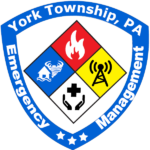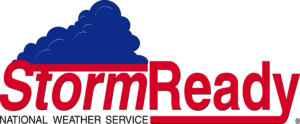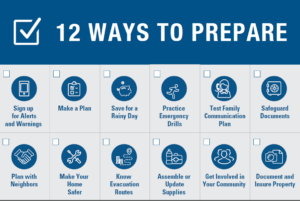
York Township Emergency Management Agency provides emergency planning for the residents, businesses and facilities located within York Township. Emergency management is staffed by trained volunteers under the leadership of an appointed Coordinator.
If anyone would like to volunteer to help or has questions about Emergency Management please contact the Coordinator by email or phone (below).
York Township EMA
196 Oak Road Dallastown, PA 17313
Phone: 717-741-3861 x189
Special Event Planning
If you are considering organizing a Special Event in York Township, there are many considerations that should go into your planning and preparing for the event. These include such factors as:
- Do I need a permit?
- Can I get permission to close our road?
- Where can I hold my event?
- What kind of written plan should I prepare?
We have created an Event Planning Resource Guide to help you with planning your event. Click here to download a brief guide that addresses the topics above (and more).
Meeting Minutes
Click the date of the meeting to view its minutes in PDF format.
Calendar of Events
Monthly Meetings: The group meets in the Training room of the York Township Administration Building on the third Thursday of each month at 6:30 p.m. Please contact Emergency Management Coordinator, Laura Kirk, if you would like to be our guest at a meeting.
Current Weather at York Township Municipal Building
This link will show you the current weather conditions as measured by our Davis WeatherLink weather station at the municipal campus.
Weather Conditions – York Township Admin Bldg (weatherlink.com)
Full Weather Station Information, including historical observations – York Township Admin Bldg
Social Media
York Township EMA is on social media!
Follow us on Facebook at York Township EMA | Facebook
We are also on NextDoor. You must live within York Township to receive our posts on your Nextdoor feed.
Preparedness, Mitigation, and Safety Tips
⭐ High Winds Mitigation Guidance on the FEMA App
|
To download the free FEMA App, go to either the App Store or Google Play. There are other features, such as emergency alerts, safety tips and resources for before, during and post disaster that are not discussed in this article. |
As we enter a period of increasing severe weather it’s time to look at potential wind damage to your home, and what you can do about it. We know about hurricanes and tornados, as these can get the most attention in the media, but damaging winds can also be in the form of straight-line winds – with wind speeds equaling a Category 2 hurricane. You can use the FEMA App to find tips to reduce your exposure. On the FEMA App touch the “Mitigate Your Risk” section; there are two parts: “Know Your Risk” and “Reduce Your Risk.” Choose the “Reduce Your Risk” and check High Winds.
Reduce Your High Wind Risk
There are steps you can take to reduce damage from high winds. The FEMA App has steps on how to assess home components and make corrective actions, followed by helpful links to publications that provide additional details. These include:
- Tie-Downs and Anchoring of Manufactured Homes – 75-80% of tornado fatalities are in homes, and over half of these are in manufactured homes, while 6% of the US building stock are manufactured homes [Prof. Stephen Strader of Villanova University]. It is important to have a wind resilient manufactured home for your safety.
- Check your Garage Door – these are typically large and unreinforced openings in your home and failure can result in contents and structural damage.
- Check your Roof Flashing – flashing keeps water from penetrating your roof and damaging interior space and contents.
- Inspect Wall-to-Foundation Anchorage – weak connections in home construction are susceptible to external forces. Especially in an area that can experience high wind, visibly inspecting the house for signs of separation will identify potential failure before it occurs. Proper anchoring of the house to the foundation may be a necessary step to secure your home.
- Install Permanent Storm Shutters or Prepare Temporary Wood Covers – especially in hurricane force wind prone areas, shutters or covers can protect windows and house contents from high winds and windblown debris. Shattered glass will provide an opening for additional storm damage.
- Reinforce Exterior Doors – just like windows, doors are penetrations into your homes protective shell. High winds finding this weakness can lead to structural damage and water intrusion.
- Secure gutters – loose gutters can take flight in a high wind event and become a projectile. In addition, if rainfall occurs with the high wind, you will be missing protection from roof runoff falling adjacent to the house foundation and causing a wet basement.
- Secure outdoor Furniture and Other Gear – this is a relatively simple step you can take to minimize damage to outdoor equipment and nearby homes. If you can’t bring the items inside, you can anchor or weigh them down.
- Strengthening Soffits – you can prevent water damage by securing the underside of your roof.
As with any activity, you should assess your abilities and only perform the FEMA App actions safely. For activities that are beyond the owner’s capabilities, check the box labeled “General Purpose” and touch “Select and Work with Contractors” for consumer tips on getting the mitigation work done.
You can use the FEMA App for tips on how to reduce your home’s vulnerability to high winds. Mitigate your risks before your phone signals a high wind warning –that blaring noise alert suggests that it is too late to do anything.
⭐ Steps to Food Safety Part 2
How do you prevent food poisoning?
An estimated 1 in 6 Americans will get sick from food poisoning this year. Food poisoning can result in a hospital stay and it can also cause long-term health problems. You can help keep your family safe from food poisoning at home by following these four simple steps:
- Clean
- Separate
- Cook and
- Chill
Separate: Don’t Cross Contaminate
Use separate cutting boards and plates for produce, meat, poultry, seafood, and eggs:
- Use one cutting board for fresh produce or other foods that won’t be cooked before they’re eaten, and another for raw meat, poultry, or seafood. Replace them when they are worn.
- Use separate plates and utensils for cooked and raw foods.
- Use hot, soapy water to thoroughly wash plates, utensils, and cutting boards that touched raw meat, poultry, seafood, eggs, or flour.
Keep certain types of food separate:
- In your shopping cart, separate raw meat, poultry, seafood, and eggs from other foods and place packages of raw meat, poultry, and seafood in plastic bags if available. When you check out, place raw meat, poultry, and seafood in separate bags from other foods.
- At home, place raw meat, poultry, and seafood in containers or sealed, leak-proof plastic bags. Freeze them if you’re not planning to use them within a few days.
- In the fridge, keep eggs in their original carton and store them in the main compartment—not in the door.
Foodsafety.gov is a great reference if you want to know more
⭐ Steps to Food Safety Part 1
How do you prevent food poisoning?
An estimated 1 in 6 Americans will get sick from food poisoning this year. Food poisoning can result in a hospital stay and it can also cause long-term health problems. You can help keep your family safe from food poisoning at home by following these four simple steps:
- Clean
- Separate
- Cook and
- Chill
Clean: Wash Hands, Utensils, and Surfaces Often
Germs that can make you sick can survive in many places around your kitchen, including your food, hands, utensils, cutting boards, and countertops.
Wash your hands the right way:
- Use plain soap and water and scrub the backs of your hands, between your fingers, and under your nails for at least 20 seconds.
- Rinse hands, then dry with a clean towel.
Wash surfaces and utensils after each use:
- Wash cutting boards, dishes, utensils, and countertops with hot, soapy water, especially after they’ve held raw meat, poultry, seafood, or eggs.
- Wash dish cloths often in the hot cycle of your washing machine.
Wash fruits and vegetables, but not meat, poultry, or eggs:
- Cut away any damaged or bruised areas, then rinse fruits and vegetables under running water without soap, bleach, or commercial produce washes.
- Scrub firm produce like melons or cucumbers with a clean produce brush.
- Dry produce with a paper towel or clean cloth towel.
- Don’t wash meat, poultry, eggs, or seafood to avoid spreading harmful germs around your kitchen.
- Produce labeled as “pre-washed” does not need to be washed again.
⭐ 12 Ways to Prepare
Pandemic. Power loss. Boil water advisory. Cyber attacks. It might seem that danger lies around every turn, and that the task of preparing for all the kinds of bad things that might happen is a daunting prospect. This is where we can benefit from reframing the task not as “PREPARING FOR EVERYTHING!!!” … but as taking some simple steps that can make us better prepared for those bad things. Here is a card that you can save or print out that lists some of the most basic steps that will make you more resilient to the threats of emergencies and disasters. Click here.
⭐ Electricity Supply for Residents Dependent on a Medical Device
If you become dependent upon electricity-powered medical devices at home, please take the following planning and preparedness steps:
- Complete a Special Needs Registry form for York County. This puts your information into the 911 System so that dispatchers can inform first responders of any access or functional needs or medical equipment dependencies. Also, if there are any emergency / disaster situations that occur in York Township, EMA can contact you with important information or, when possible, status checks. There is an online form located on the York County Office of Emergency Management web site. Navigate as follows: To YorkCountyPA.gov > Emergency Services > Emergency Management > York County Special Needs Registry. On this page, you can complete the online form to be included on the registry. Please be aware that any information provided is treated confidentially, and that no specific medical diagnosis information is requested.
- Contact your electricity provider (in York Township, this is MetEd). Tell the representative that you want to request a “Critical Care Form.” The phone support person should be familiar with this form. It must be returned within 10 days of receipt. The form requires information and certification by the physician who has ordered the home medical equipment. Only certain equipment qualifies – be sure you verify with the MetEd phone representative whether your equipment qualifies. MetEd does not guarantee that your home will receive power 24x7x365, but people who sign up will receive priority restoration. Contact the regular customer service number that is listed on your MetEd bill for information on signing up for Critical Care priority restoration.
- Because of the possibility of a lapse in electricity restoration, residents should plan and prepare to have a backup source of power for interim power needs. Consult your medical equipment provider for information on power needs and recommendations for your specific equipment.
StormReady Certification
York Township has been StormReady certified since 2010. We received a 4-year renewal in September, 2023. To receive StormReady certification, a community must:
- Establish a 24-hour warning point and emergency operations center
- Have more than one way to receive severe weather warnings and forecasts and to alert the public
- Create a system that monitors weather conditions locally
- Promote the importance of public readiness through community seminars
- Develop a formal hazardous weather plan, which includes training severe weather spotters and holding emergency exercises.
Amateur Radio Licensing Class
A few times each year, York Township EMA hosts an amateur radio Technician Class licensing class. The session is led by an experienced amateur radio operator and serves as a “prep session” to pass the FCC license test. There is more information available at the York Township Rec. Dept. web site.
Contact Emergency Management Coordinator
> Contact Emergency Management Coordinator (Online Form)
.
.
.
.
.
Websites for Emergency Situations
Below are some links to emergency related sources for more information.
- 511PA Pennsylvania Traffic and Travel Information
- Center for Disease Control and Prevention (CDC)
- National Weather Service (NWS)
- Pennsylvania Dept. of Health (PA-DOH)
- Pennsylvania Emergency Management Agency (PEMA)
- Ready.Gov (FEMA)
- The White House
- York County Regional Police (YCRP)
- York County Live Incident Status

